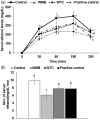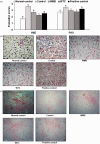Mulberry and dandelion water extracts prevent alcohol-induced steatosis with alleviating gut microbiome dysbiosis
- PMID: 30105955
- PMCID: PMC6108054
- DOI: 10.1177/1535370218789068
Mulberry and dandelion water extracts prevent alcohol-induced steatosis with alleviating gut microbiome dysbiosis
Abstract
Chronic alcohol intake causes hepatic steatosis and changes the body composition and glucose metabolism. We examined whether water extracts of mulberry (WMB) and white flower dandelion ( Taraxacum coreanum Nakai, WTC) can prevent and/or delay the symptoms of chronic ethanol-induced hepatic steatosis in male Sprague Dawley rats, and explored the mechanisms. Ethanol degradation was examined by orally administering 3 g ethanol/kg bw after giving them 0.3 g/kg bw WMB or WTC. All rats were continuously provided about 7 g ethanol/kg bw/day for four weeks and were given either of 0.1% dextrin (control), WMB, WTC, or water extracts of Hovenia dulcis Thunb fruit (positive-control) in high-fat diets. Area under the curve of serum ethanol levels was lowered in descending order of control, WTC and positive-control, and WMB in acute ethanol challenge. WMB and WTC prevented alcohol intake-related decrease in bone mineral density and lean body mass compared to the control. After glucose challenge, serum glucose levels increased more in the control group than other groups in the first part and the rate of decrease after 40 min was similar among all groups. These changes were associated with decreasing serum insulin levels. WMB had the greatest efficacy for decreasing triglyceride and increasing glycogen deposits. WMB and WTC prevented the disruption of the hepatic cells and nuclei while reducing malondialdehyde contents in rats fed alcohol, but the prevention was not as much as the normal-control. The ratio of Firmicutes to Bacteroidetes in the gut was much higher in the control than the normal-control, but WTC and WMB decreased the ratio compared to the control. WMB and WTC separated the gut microbiota community from the control. In conclusion, WMB and WTC protected against alcoholic liver steatosis by accelerating ethanol degradation and also improved body composition and glucose metabolism while alleviating the dysbiosis of gut microbiome by chronic alcohol intake. Impact statement Excessive alcohol consumption is associated with serious pathologies and is common in much of the world. Pathologies include liver damage, glucose intolerance, and loss of lean body mass and bone mass. These pathologies are mediated by changes in metabolism as well as toxic metabolic byproducts, and possibly by gut dysbiosis. In this study, we demonstrate that aqueous extracts of mulberry and dandelion protected rats against ethanol-induced losses in lean body and bone masses, improved glucose tolerance and partially normalized gut bacterial populations, with mulberry extract being generally more effective. This research suggests that mulberry and dandelion extracts may have the potential to improve some of the pathologies associated with excess alcohol consumption, and that further clinical research is warranted.
Keywords: Alcohol; dandelion; glucose metabolism; gut microbiome; mulberry.
Figures






Similar articles
-
Red mulberry fruit aqueous extract and silk proteins accelerate acute ethanol metabolism and promote the anti‑oxidant enzyme systems in rats.Mol Med Rep. 2018 Jul;18(1):1197-1205. doi: 10.3892/mmr.2018.9017. Epub 2018 May 14. Mol Med Rep. 2018. PMID: 29767238
-
Ethanol extract of mulberry leaves partially restores the composition of intestinal microbiota and strengthens liver glycogen fragility in type 2 diabetic rats.BMC Complement Med Ther. 2021 Jun 14;21(1):172. doi: 10.1186/s12906-021-03342-x. BMC Complement Med Ther. 2021. PMID: 34126977 Free PMC article.
-
Combination of Aronia, Red Ginseng, Shiitake Mushroom and Nattokinase Potentiated Insulin Secretion and Reduced Insulin Resistance with Improving Gut Microbiome Dysbiosis in Insulin Deficient Type 2 Diabetic Rats.Nutrients. 2018 Jul 23;10(7):948. doi: 10.3390/nu10070948. Nutrients. 2018. PMID: 30041479 Free PMC article.
-
Meta-analysis of alcohol induced gut dysbiosis and the resulting behavioral impact.Behav Brain Res. 2019 Dec 30;376:112196. doi: 10.1016/j.bbr.2019.112196. Epub 2019 Aug 30. Behav Brain Res. 2019. PMID: 31476330 Review.
-
The Gastrointestinal Microbiome: Alcohol Effects on the Composition of Intestinal Microbiota.Alcohol Res. 2015;37(2):223-36. Alcohol Res. 2015. PMID: 26695747 Free PMC article. Review.
Cited by
-
Mixture of blackberry leaf and fruit extracts alleviates non-alcoholic steatosis, enhances intestinal integrity, and increases Lactobacillus and Akkermansia in rats.Exp Biol Med (Maywood). 2019 Dec;244(18):1629-1641. doi: 10.1177/1535370219889319. Epub 2019 Nov 21. Exp Biol Med (Maywood). 2019. PMID: 31752528 Free PMC article.
-
Nutrition Strategy and Life Style in Polycystic Ovary Syndrome-Narrative Review.Nutrients. 2021 Jul 18;13(7):2452. doi: 10.3390/nu13072452. Nutrients. 2021. PMID: 34371961 Free PMC article. Review.
-
Plant-Based Foods and Their Bioactive Compounds on Fatty Liver Disease: Effects, Mechanisms, and Clinical Application.Oxid Med Cell Longev. 2021 Mar 1;2021:6621644. doi: 10.1155/2021/6621644. eCollection 2021. Oxid Med Cell Longev. 2021. PMID: 33728021 Free PMC article. Review.
-
Protection against Neurological Symptoms by Consuming Corn Silk Water Extract in Artery-Occluded Gerbils with Reducing Oxidative Stress, Inflammation, and Post-Stroke Hyperglycemia through the Gut-Brain Axis.Antioxidants (Basel). 2022 Jan 16;11(1):168. doi: 10.3390/antiox11010168. Antioxidants (Basel). 2022. PMID: 35052672 Free PMC article.
-
Polyphenols as modulators of pre-established gut microbiota dysbiosis: State-of-the-art.Biofactors. 2022 Mar;48(2):255-273. doi: 10.1002/biof.1772. Epub 2021 Aug 16. Biofactors. 2022. PMID: 34397132 Free PMC article. Review.
References
-
- Organization WH. Global health observatory data. Prevalence of alcohol use disorders. Washington DC, United States: World Health Organization, 2010
-
- Tilg H, Day CP. Management strategies in alcoholic liver disease. Nat Rev Gastroenterol Hepatol 2007; 4:24–34 - PubMed
Publication types
MeSH terms
Substances
LinkOut - more resources
Full Text Sources
Other Literature Sources
Medical

